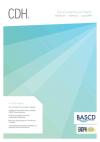Community Dental Health

- Cover Date:
- June 2019
- Print ISSN:
- 0265 539X
- Electronic ISSN:
- 2515-1746
- Vol:
- 36
- Issue:
- 2
What influences use of dental services by the Korean disabled people? The role of perceived barriers in dental care system
10.1922/CDH_4456Young05
Objective: To identify the perceived barriers to dental care for disabled people in South Korea using the revised Andersen’s model of access to health care. Basic research design: Cross-sectional analytic interview study. Participants: Korean people with a disability residing
in residential facilities, or those at home who attend vocational rehabilitation facilities, special schools, or welfare facilities, were sampled
from Seoul and non-Seoul areas in 2016 and were interviewed face-to-face. In total, 456 disabled Koreans, or their primary caregivers
participated. Results: Household income, disability duration and perceived barriers in the dental care system were perceived to impact
on dental care utilisation, while the need for dental care services did not significantly explain the use of dental care by disabled people
in South Korea. Those with low household incomes were less likely to use dental care services, compared to people with moderate and
high household incomes. As disability duration increased, disabled people were more likely to use dental services. Those who perceived
the barriers to dental care as higher were less likely to use dental services. Conclusion: These data suggest that policies are needed to
support disabled people with low household incomes. Lowering barriers in the dental care system may encourage people with disabilities
to access timely and adequate dental services.
Keywords: Barriers, dental care, disability, Andersen model, enabling factors, South Korea
- Article Price
- £15.00
- Institution Article Price
- £
- Page Start
- 101
- Page End
- 105
- Authors
- Young-Jae Kim, Yeong-Woo Lim, Hye-Ran Paik, Jae-Young Lee, So-Yun Kim
Articles from this issue
- Title
- Pg. Start
- Pg. End
- Editorial - How soon is soon enough? The challenge of implementing behaviours conducive to good oral health in at-risk infants and toddlers
- 89
- 90
- What influences use of dental services by the Korean disabled people? The role of perceived barriers in dental care system
- 101
- 105
- In-school toothbrushing programs in Aboriginal communities in New South Wales, Australia: A thematic analysis of teachers’ perspectives
- 106
- 110
- Relationship between Caregivers’ Oral Health Literacy and their Child’s Caries Experience
- 111
- 117
- The Effectiveness of Reform in the Dental Health Systems of Transitional Countries: The Case of Montenegro Health Reform (pilot study)
- 126
- 130
- Costs of dental care and its financial impacts on patients in a population with low availability of services
- 131
- 136
- Comparison of two measures to determine the oral health-related quality of life in elders with periodontal disease
- 143
- 149
